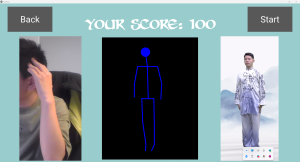As we are approaching the end of semester, our team worked on integration and finetuning the infrastructure for the upcoming testing and verfication.
Jerry has been focused on enhancing the user experience by introducing custom pose sequence support. He’s also succeeded in integrating the app with file manager to handle multiple files, providing users with an efficient way to manage their custom pose uploads. Additionally, Jerry has improved user interaction by enabling the removal and reordering of files to be uploaded, directly within the app’s display.
Shiheng has taken on the challenge of allowing pose selection from multiple persons, a crucial feature for users within more complex environments and handling different outputs when multiple bodies are found in frame. In addition, he is concentrating on backend support for skeleton drawing for Ray, implementing a new and different approach for measuring angles that could be handled better on the frontend without the need for processing the raw data from Openpose.
Hongzhe (Eric) is dedicated to refining the visual aspects of the application. His work involves processing reference images to enhance their display quality. He is also focusing on establishing parameter connections, which will contribute to a more cohesive and user-friendly experience. Additionally, Hongzhe is also involved in fine-tuning the logic on the training page to ensure an optimized user journey.
Ray is playing a pivotal role in consolidating the efforts of the team. He is synthesizing key points and reference angles provided by Shiheng into the overall skeleton drawing process. Ray is also leading the redesign of UI components for improved aesthetics and usability, working on cleaning up the code and optimization. Furthermore, he is involved in refactoring reference pictures to enhance user experience with bigger picture components for better feedback experience.
ABET Question (How we have grown as a team?):
Throughout the semester, our team has experienced substantial growth and cohesion. We have established a robust framework for collaboration and decision-making, utilizing Google Drive for weekly reports, design documents, Github repo for codes, and Slack channel for communication and collaboration efforts.
Our mandatory lab sessions on Mondays and Wednesdays have provided consistent opportunities for team members to discuss progress and align our efforts. Additionally, our Friday or Saturday sessions over zoom have been dedicated to refining plans and syncing up progress during the week.
The use of Gantt Charts has proven instrumental in visualizing our project timeline and ensuring that tasks are allocated efficiently. This strategic planning has allowed us to stay on track and adapt to unforeseen challenges effectively. By regularly revisiting and adjusting our goals based on progress and feedback, we have fostered a dynamic and adaptive team culture.
Our commitment to an open and inclusive environment has been foundational to our success. We actively seek input from all team members, ensuring that each voice is heard and valued. Though we faced changes in group composition and change of plan in the beginning of the semester, everyone in the group was equally treated.
Thanks to everyone’s effort in creating an equal and exclusive environment, we have been able to make substantial progress from scratch as a group and advance through the hardships we faced throughout the semester.


